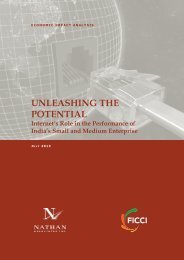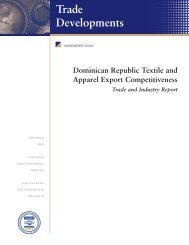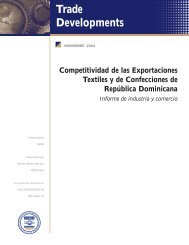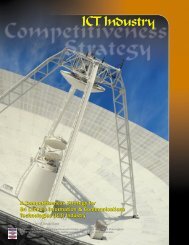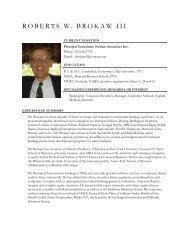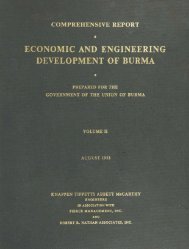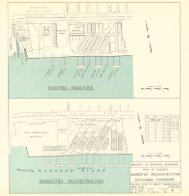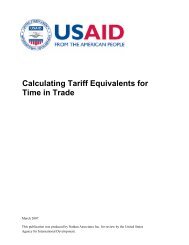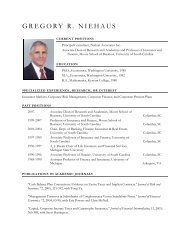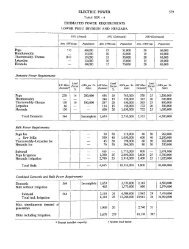Putting it to Work in Developing Countries - Nathan Associates
Putting it to Work in Developing Countries - Nathan Associates
Putting it to Work in Developing Countries - Nathan Associates
You also want an ePaper? Increase the reach of your titles
YUMPU automatically turns print PDFs into web optimized ePapers that Google loves.
PRIVATE INFRASTRUCTURE DEMAND<br />
Robust long-term economic growth and development<br />
requires cost-effective, reliable <strong>in</strong>frastructure—power,<br />
transport, telecommunications<br />
and water-san<strong>it</strong>ation. Everywhere <strong>in</strong> the<br />
develop<strong>in</strong>g world, expand<strong>in</strong>g economies and<br />
populations are putt<strong>in</strong>g enormous pressure on<br />
<strong>in</strong>adequate <strong>in</strong>frastructure systems and service<br />
delivery. Serious <strong>in</strong>frastructure deficiencies<br />
threaten <strong>to</strong> disrupt economic progress. Faced<br />
w<strong>it</strong>h fiscal defic<strong>it</strong>s, governments are unable or<br />
unwill<strong>in</strong>g <strong>to</strong> <strong>in</strong>vest <strong>in</strong> new facil<strong>it</strong>ies. In India, for<br />
example, “the s<strong>in</strong>gle most important macro constra<strong>in</strong>t<br />
on the Indian economy, hold<strong>in</strong>g back <strong>it</strong>s<br />
average growth, is the low spend<strong>in</strong>g on <strong>in</strong>frastructure.”<br />
16<br />
One obvious solution is private provision of<br />
<strong>in</strong>frastructure through public–private partnerships.<br />
Private <strong>in</strong>frastructure projects can take a<br />
variety of forms, among them nonequ<strong>it</strong>y<br />
arrangements, but much of the large-scale<br />
upgrade and expansion needed <strong>in</strong> the develop<strong>in</strong>g<br />
economies requires significant private <strong>in</strong>vestment,<br />
<strong>in</strong>clud<strong>in</strong>g FDI by mult<strong>in</strong>ationals w<strong>it</strong>h<br />
expertise <strong>in</strong> design<strong>in</strong>g, build<strong>in</strong>g, and operat<strong>in</strong>g<br />
power, transportation, telecommunications, and<br />
water-san<strong>it</strong>ation systems. Indian policymakers,<br />
for example, have called for roughly $155 billion<br />
<strong>in</strong> FDI for <strong>in</strong>frastructure over the next ten<br />
years, <strong>in</strong>clud<strong>in</strong>g $55 billion <strong>in</strong> airports and railways<br />
<strong>in</strong> the next decade, and $75 billion <strong>in</strong><br />
power and $25 billion <strong>in</strong> telecommunications <strong>in</strong><br />
the next five years alone. 17<br />
Market-seek<strong>in</strong>g FDI has already played a significant<br />
role <strong>in</strong> <strong>in</strong>frastructure projects <strong>in</strong> develop<strong>in</strong>g<br />
countries. 18 In the 1990s <strong>in</strong>vestment boomed,<br />
go<strong>in</strong>g from $13 billion <strong>in</strong> 1990 <strong>to</strong> $114 billion<br />
<strong>in</strong> 1997. Privatization of telecoms and electric<br />
power util<strong>it</strong>ies through cross-border M&As and<br />
concessions <strong>in</strong> Lat<strong>in</strong> America drove much of this<br />
flow, as well as greenfield FDI projects for <strong>in</strong>dependent<br />
power plants <strong>in</strong> East Asia. But all<br />
regions and all <strong>in</strong>frastructure sec<strong>to</strong>rs received<br />
flows. After peak<strong>in</strong>g <strong>in</strong> 1997, <strong>in</strong>vestment<br />
decl<strong>in</strong>ed steadily <strong>to</strong> $53 billion <strong>in</strong> 2003. 19 East<br />
Asia and Lat<strong>in</strong> America, where the boom<br />
occurred, suffered the worst decl<strong>in</strong>es. This drop<br />
reflected deteriorat<strong>in</strong>g cond<strong>it</strong>ions for private<br />
<strong>in</strong>frastructure f<strong>in</strong>ance, beg<strong>in</strong>n<strong>in</strong>g w<strong>it</strong>h the Asian<br />
F<strong>in</strong>ancial Crisis, followed by a severe economic<br />
slump <strong>in</strong> Brazil, further crises <strong>in</strong> Russia and<br />
Argent<strong>in</strong>a, the collapse of world s<strong>to</strong>ck markets,<br />
and corporate scandals, <strong>in</strong>clud<strong>in</strong>g that of Enron,<br />
a high-profile provider of <strong>in</strong>frastructure FDI. 20<br />
Under economic stress, the weak design of<br />
boom-time projects emerged—impractical pric<strong>in</strong>g<br />
provisions, <strong>in</strong>adequate regula<strong>to</strong>ry structures,<br />
<strong>in</strong>attention <strong>to</strong> needs for compet<strong>it</strong>ion, and unsusta<strong>in</strong>able<br />
government guarantees. This led <strong>to</strong> disputes<br />
between <strong>in</strong>ves<strong>to</strong>rs and states, renegotiation<br />
or closure of projects, and a depressed market<br />
for <strong>in</strong>frastructure FDI.<br />
In the last two years, however, the trend <strong>in</strong> private<br />
<strong>in</strong>frastructure <strong>in</strong>vestment has aga<strong>in</strong> turned<br />
pos<strong>it</strong>ive. In 2005, a <strong>to</strong>tal of $96 billion <strong>in</strong> comm<strong>it</strong>ments<br />
for <strong>in</strong>frastructure <strong>in</strong>vestments w<strong>it</strong>h<br />
private participation was reported, w<strong>it</strong>h new alltime<br />
highs <strong>in</strong> telecoms ($60 billion), airports<br />
($7.5 billion), and seaports ($5.4 billion). All<br />
regions now show recovery from the lows of<br />
2002–2003, w<strong>it</strong>h Europe and Central Asia and<br />
South Asia sett<strong>in</strong>g records. In view of the massive<br />
need for <strong>in</strong>frastructure improvement <strong>in</strong><br />
develop<strong>in</strong>g economies, this cycle of private <strong>in</strong>frastructure<br />
<strong>in</strong>vestment will surely ga<strong>in</strong> momentum<br />
over the next 10 <strong>to</strong> 15 years, particularly if lessons<br />
about realistic pric<strong>in</strong>g, compet<strong>it</strong>ion<br />
arrangements, regulation, and risk m<strong>it</strong>igation<br />
have been learned. The result will be new and<br />
important opportun<strong>it</strong>ies for FDI among marketseek<strong>in</strong>g<br />
<strong>in</strong>frastructure mult<strong>in</strong>ationals, both <strong>in</strong><br />
greenfield and cross-border M&As. And because<br />
dependable <strong>in</strong>frastructure is a prerequis<strong>it</strong>e for all<br />
foreign <strong>in</strong>vestments (Chapter 5 below), <strong>in</strong>frastructure<br />
FDI may be expected <strong>to</strong> re<strong>in</strong>force new<br />
FDI flows <strong>to</strong> all sec<strong>to</strong>rs.<br />
SOUTH–SOUTH FDI FLOWS<br />
Accord<strong>in</strong>g <strong>to</strong> a World Bank survey of FDI<br />
<strong>in</strong>flows and outflows <strong>in</strong> a sample of develop<strong>in</strong>g<br />
countries, South-based mult<strong>in</strong>ational enterprises<br />
became much more active <strong>in</strong> FDI transactions<br />
dur<strong>in</strong>g the 1990s. South–South flows may now<br />
52



